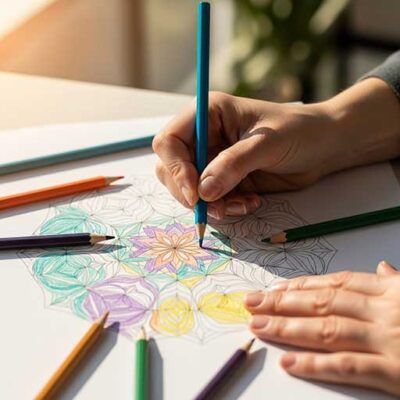Other
Creative Meditation: Finding Mindfulness and Calm in Every Coloring Stroke
Creative Meditation: Finding Mindfulness and Calm in Every Coloring Stroke
I once ran a workshop for a group of burnt-out professionals. When I pulled out a stack of coloring pages, one woman—let’s call her Sarah—laughed. “Coloring?” she said, phone in hand. “I don’t have time for arts and crafts.”
I just smiled and placed a mandala pattern in front of her. “Give me fifteen minutes,” I said.
She sighed, put her phone down, and reluctantly picked up a blue pencil. At first, her movements were stiff. But after a few minutes, something shifted. Her shoulders dropped. Her breathing slowed. By the end of the session, she looked up and said, “I don’t think I thought about a single deadline for that entire time.”
That’s the magic. This isn’t about creating a masterpiece. It’s a practice I call creative meditation, and it’s one of the most accessible mindfulness tools I’ve ever seen.
What Exactly Is Creative Meditation?
Traditional meditation can be intimidating. The pressure to sit still and “empty your mind” is often too much. Creative meditation is different.

Instead of fighting to empty your mind, you give it something simple to focus on. It’s mindfulness in motion. By concentrating on the repetitive act of applying color to paper, you anchor yourself in the present. The texture of the page, the sound of the pencil, the choice of a new color—these small details become your entire world for a little while.
It gives your brain’s overthinking, analytical side a much-needed break. All that mental chatter about bills and schedules recedes into the background, because the part of your brain responsible for motor skills and senses is now running the show.
Field Notes: The Skeptic’s Breakthrough
Remember Sarah? She came up to me afterward, holding her half-finished mandala. “It’s funny,” she admitted, “I was so focused on trying to stay inside the tiny lines that I completely forgot to worry about that presentation I have on Friday.” She wasn’t an artist. She was just a stressed person who found an unexpected off-ramp from her anxiety loop, one pencil stroke at a time.
The Surprising Science Behind Coloring and Calm
Sound a bit too simple to be true? There’s real science to back it up. Engaging in a structured, repetitive activity like coloring can induce a meditative state. Carl Jung even used mandalas with his patients to help them find focus.
Here’s a quick look at what’s happening:
- It Lowers the Stakes: A coloring page removes the pressure of the blank canvas. The structure is already there, which allows your mind to relax.
- It Engages the Whole Brain: Logic (staying in the lines) and creativity (choosing colors) work together, leading to a more integrated, focused state.
- It Replaces Negative Thoughts: You can’t actively worry about a problem when you’re deeply focused on whether to use teal or turquoise. This gentle redirection of attention is the core of mindfulness.
Getting Started with Creative Meditation: A Practical Guide
The beauty of this practice is its simplicity. You don’t need a special room or expensive equipment.
Choosing Your Tools (Without Overthinking It)
Don’t get stuck shopping for supplies. A basic pack of crayons or colored pencils is all you need. The key is to choose something you enjoy the feel of.
Setting the Scene (or Not)
Do you need a silent, candle-lit sanctuary? Absolutely not. Some of the most profound moments of calm happen in the middle of everyday life.
Field Notes: The Ten-Minute Reset
A father I worked with, Mark, felt perpetually overwhelmed. His “meditation” became a ten-minute ritual after putting the kids to bed. He’d sit at the messy kitchen table and color one small section of a complex page. He said it was the only time of day his brain felt truly his own. It wasn’t about finishing the page; it was about reclaiming those ten minutes.
You can do this on your lunch break, on the train, or while listening to a podcast. The point is to integrate it into your life, not add another item to your to-do list.
The “How-To”: Letting Go of Perfection
This is the most important part. The goal is process, not product. What if you go outside the lines? Who cares! There is no art police.
As you start, focus on the sensory details:
- Listen to the sound the pencil makes on the paper.
- Feel the pressure of the pencil in your hand.
- Observe the color filling the white space without judgment.
If your mind wanders, gently guide it back to the color in front of you. That’s the entire practice.
Beyond Coloring: Expanding Your Practice

Once you get the hang of it, you’ll see this principle everywhere. Mindful doodling, Zentangle patterns, or even knitting can serve the same purpose. It’s any creative act that allows you to focus on simple, repetitive motions.
Field Notes: The Classroom Calmer
A third-grade teacher, Mrs. Davis, started using this after recess. For five minutes, she’d put on quiet music and the kids would color. She told me it completely changed her afternoons. The kids were more settled and focused. She wasn’t teaching art; she was teaching them how to self-regulate.
Ultimately, creative meditation is a quiet rebellion against our culture of constant hustle. It’s a reminder that peace isn’t something you have to chase; sometimes, it’s something you can create with your own two hands.
So, where do you begin? Forget about finding the perfect book or the right pens. Just find a piece of paper and a single color.
Give yourself ten minutes tonight. Don’t try to make anything beautiful. Just make a mark on the page and see what happens.
Ready to give it a try? We’ve curated a collection of [free, printable coloring pages] to help you get started on your creative meditation journey.
[Shop Now] | [Get a Free Sample] | [Available on Amazon]
